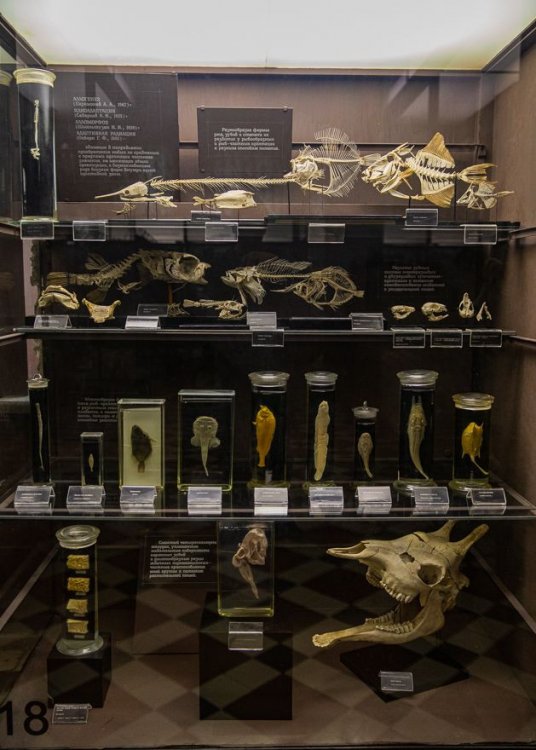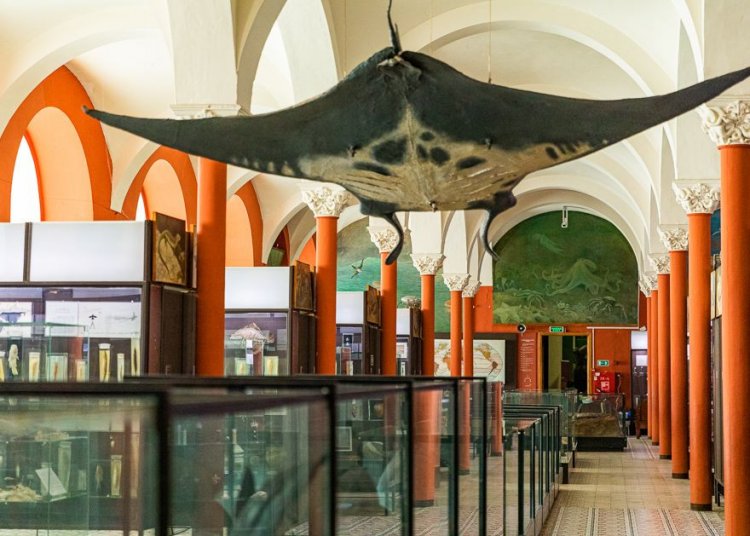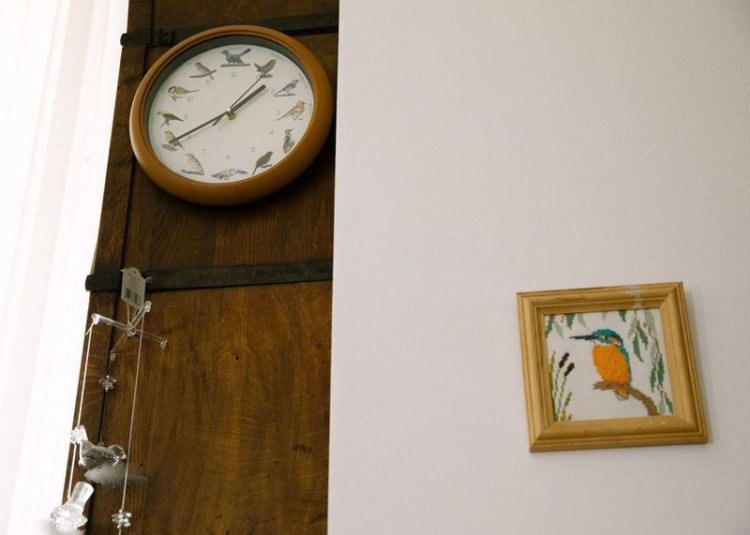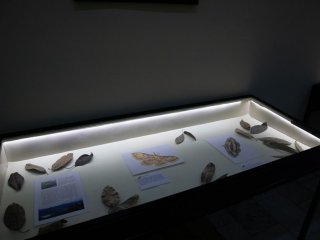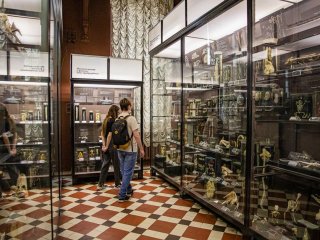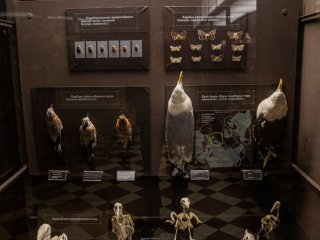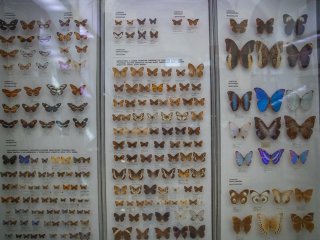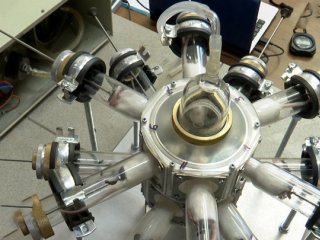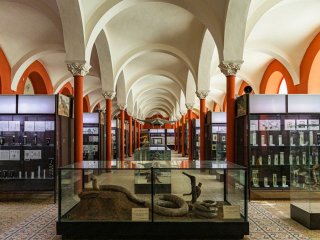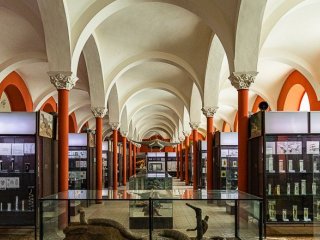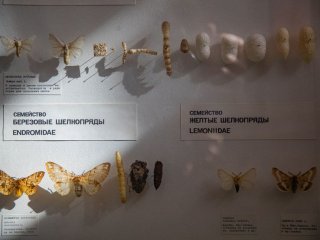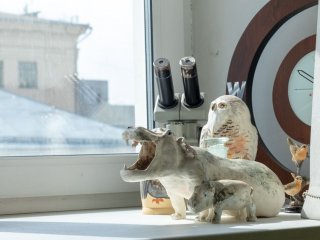What is going on outside the museum rooms opened for visitors? How did researchers of the Moscow State University discover 250 previously unknown organisms? What is birdwatching? Director of the MSU Zoological Museum, Dr. Sc. in Biology, Mikhail Kalyakin answered these questions.
Good afternoon, Mikhail Vladimirovich! The museum where we are now is unusual. It has two lives — museum and research, is that right?
Let me correct you, we have three lives. Not to mention a finer division, as we also have one more very important, fundamental part of our work – work with collections unavailable to the general public. The part of the museum’s life that is open to the public is a sort of an educational project, an outreach project. People go to the museum to learn about the diversity of contemporary animals. But behind the curtain is us working with collections.
We have tours, lectures, interactive lessons alright. It’s a big part of our life. So, yes, we have that part, too. As for the research life, it is somewhat hidden from visitors. The building is planned so that there is an open area where visitors can walk and there is a closed area where we keep zoological collections and those researchers who study or store collections have a place to work. More accurately, it’s not “or” but “and,” as we have an organization that gathers, stores and then uses scientific zoological collections referring to contemporary animals.
It should be pointed out that there are many animals; much more than we can ever imagine. There are several million species of insects alone and assumption is that there are as many species we yet have to discover. Or even more. There are many groups of invertebrates that you haven’t even seen and heard about. Some mysterious bryozoa, sea cucumbers, sea stars, roundworms, ribbon worms... Few even heard these names back in school. The diversity of animals is much greater than the diversity of specialists who study them.
Our task is to study the biodiversity of the animal kingdom.
Today, museum collections include thousands of exhibits. What is happening to them and are they getting expanded?
Let me correct you, around ten thousand exhibits. This display is hardly ever expanded, but we slightly update it. Something is slightly renewed, but museum workers have a rule established over centuries — the display must be changed once every 30 to 40 years. Not only because scientific notions are changing, but also because in 30 to 40 years, theoretically speaking, everyone saw this display. So, let’s remake it somehow.
In our and other conditions, the main problems are probably the venue, funding, and a chance to gather a team who will, among other things, look at it from an artistic point of view. Because the display we have now includes a scientific component (researchers must make sure that animals are arranged by kinship, i.e., taxonomy, scientifically speaking).
In other words, we have a taxonomic display rather than a geographic display.
The display we have now was created relatively recently, in the 1980s, and has not lost its scientific “correctness” just yet. But taxonomy specialists are doing their best to move some groups elsewhere. In the meantime, we had genetic studies, during which we used DNA analysis to reveal kinship between species and higher tier groups. From time to time, there are some silent revolutions in taxonomy.
I should say almost for advertising purposes that our display is pretty good. Our specialists spent a lot of time to create it and I was partly involved in all of this. It introduces the public to the diversity of contemporary animals. The exhibits have been accumulated for many decades and now we can show the diversity of animals of our entire planet. Currently, we are prone to change the display surgically: this bird should be replaced with that one, this fish withered and needs to be replaced with a fresher one if available.
The museum storage unavailable to the public is commonly thought to account for up to ten million items. Maybe less, but in any case, not less than seven and a half million. It will take us a couple of years to calculate all of them. Because these could be cans with krill (small crustaceans), for example, and a single can might have up to a thousand specimens.
So, it’s not just the gross volume that counts, but that more or less all animal groups are represented. They are stored like books in the library or like archives. It’s better to compare them with archives. Biodiversity archives.
The museum has a small room — DNA laboratory. What kind of a room is it?
After Harry Potter, everyone expects some chamber of secrets. But our chamber is not very secret, but still secret in the sense that neither the dean of the faculty of biology, which we are part of, nor the rector of the university has ever been inside. It is a clean room. It takes a long time to clean it after any visit without special equipment and clothes. You are allowed to enter it, if you wear a would-be space suit. If I ever want to visit it, I should have such a suit purchased or ordered, because an employee who works there is much shorter than me. Neither the rector, nor I can force ourselves into her suit.
Why such space conditions? This is a laboratory dealing with the old or historical DNA. Look, we have a blood test. It’s fresh and contains a lot of our DNA. We can start a process and analyze it. All’s good. Museum collections have been accumulated for 30 to 50 and 150 years since the time of Fischer von Waldheim, the first true director of the museum. There are exhibits, which are more than 100 and even 150 years. Due to the time passed, storage conditions, impact of chemical substances, long DNA sequences are destroyed and fragmented into short pieces. And it’s much, much harder to get them out there by purely chemical methods than out of a fresh biological material. But there are cases, for example, such as the most obvious one is that we want to take a look at the mammoth’s DNA. This is probably impossible in the fresh form, alas. No matter how long you ride our tundra, you won’t catch a mammoth out there. And the exhibits, which are in abundance in museums, are “only” twenty to thirty thousand years old. This is not a dinosaur, but a contemporary animal, in opinion of the biologist. We can get its DNA right here, in the museum.
And how do employees receive a genetic material?
The best option, as far as I know, is to use bones. A portion of the bone material is drilled out. It was preserved up to a certain extent. It was barely affected by radiation, sunlight, acid rains, bacteria. Inside it is kept clean in a fashion. The problem is that there is clearly less DNA in this material than in a portion of fresh blood. As a result, all further manipulations with mapping the real sequence of nucleotides constituting DNA are harder, longer and more expensive. The main task is to take these bits of DNA and use the bioinformation analysis to “assemble” source sequences from them. Yes, all experiments with the historical DNA are longer and more expensive than with the fresh one, but the problem is now more technological. There is one more problem. Many animals were preserved not in alcohol, in which DNA doesn’t degrade or degrades but not that dramatically. But if this is formalin, it’s a completely different chemistry, as DNA molecules are torn into small pieces in this solution. And making a long sequence from them, which can be compared to existing ones, is a hundredfold harder than with the old DNA. The fight against problems, which exhibits stored in formalin create, is currently in full swing.
I can quite boldly refer to my employees and say that we were the first in the country to build such a laboratory, at least when it comes to museums. The historical DNA was the subject of research chiefly in connection with solving the human DNA matters: the imperial family and things like that, the study of which requires researchers to take DNA out of the hundred-year-old biomaterial.
In 2018, the MSU completed a large-scale project intended to create the Noah’s Ark biodepository. It is designed to collect biomaterials of all living things on Earth. Can you tell us what results you have got during this time?
To us, the depository project is a very strange, unusual era, as “common” zoological and botanical studies seem too simple, descriptive to many people: who lives where, how it is called, what biological features it has, how it builds nests and what it feeds on. Biology, which, on the surface, seems to be clear and familiar. The main science is molecular studies, that is physiology, biochemistry, biophysics, immunology and entry into medicine, because it is more interesting to a person than the behavior of a butterfly, which lives somewhere in Altay. So, when the top management of our university decided to file an application for a big grant in 2014, which would be dedicated to biological collections and their use, it was a big and joyful surprise.
The leadership of several faculties who are doing biological studies made a point that biotechnologies are the future. For example, we talked a lot about DNA, as knowledge of molecular genetics makes it possible to affect the human transmittable diseases. It is important and interesting, more interesting than a fish in a jar. Maybe that’s just two steps away from cloning a mammoth? Such ideas have existed and continue to exist.
We gathered a team of more than three hundred people. It was divided into five clusters. We were interested in a group, which, I think, was poorly named “Animals.” It doesn’t sound quite right when viewed from the outside. Zoological studies would probably be better. As a result, we had a company, which was then named Noah’s Ark. Noah’s Ark, because “two of every kind,” as the phrase goes: here’s algae and Guinea pigs.
There were interesting things, which were also related to medicine. We had a medical cluster and things, which started with zoology but also worked for medicine. An entire group dealt with naked mole rats. These are such unusual animals, far from pleasant in appearance, as they are really naked, blind, covered in wrinkles like a newborn baby. Most importantly, they don’t have cancer and live as if forever dying of injuries rather than of any diseases. A group that studied them has explored and continues to explore ageing and immunity. Why do humans have cancer and these animals don’t? The question is truly important and interesting.
What are 250 unknown organisms that you have discovered as part of this project?
Everything around us other than, let’s say, the subway and downtown, is ecosystems, which in one way or another are full of life. There are soil-dwelling invertebrates, mushrooms and bacteria. We cannot see most of such things with the naked eye. And, of course, ecosystems include the plants, animals, and mushrooms that we know a few things about. Ecosystems existed and operated without humans. Everything was up and running in them over many millions of years and the humans who emerged, reproduced and spread, started to change them in a quite serious manner. They were mainly simplified and destroyed with the biodiversity reduced, that is with the number of species decreased. But we haven’t studied this biodiversity yet. We haven’t described all the species, which live on our planet. With rain forests cut down, we lose species we don’t even know about. Hundreds of hectares of Amazon rain forests disappear just in a few days. They were full of insects, worms and maybe even birds, which the science has not described yet. And this description of the biodiversity on our planet goes on. The description of the biodiversity includes fundamental biological questions. How did it emerge, how does it evolve, what laws is it subject to, how come a dove doesn’t look like a hazel grouse? Why does one have spots on feathers and the other doesn’t? Absolutely simple, “foolish” questions, but for now without answer in many respects... And among them is a very global question to know what else shares our planet with us.
In four years of our project, those several dozens of people who study different groups of animals, plants and mushrooms described that many new species. This suggests that we don’t know just yet what lives next to us. Why is it important? For example, there are malaria mosquitoes. Everyone knows that malaria is a disease widely spread in Africa, Asia, and tropics. For a person to get infected, they must be bitten by a mosquito carrying contagious protozoa. Those sit inside its proboscis waiting to get into our blood. There are some species of malaria mosquitoes that are dangerous for us, in some cases lethal. Its relative, noted for subtle structure features, is absolutely harmless, but few people know about these differences. You have to be a specialist who can tell that this is a malaria mosquito and that one isn’t. We described a new species and it turns out to be carrying malaria, too. And we don’t know anything about its biology or spread. We will probably have to establish a whole new institute to study it! Therefore, describing new species remains to be a very important matter, so important that it is even hard for me to explain it. I think, it is absolutely obvious.
Does the description continue?
It does and will. At the Moscow State University, we have the White Sea Biological Research Station (I grew up at this station, because my mother worked there). It was established in 1938. It recently celebrated the 80th anniversary. When it turned 70, the station released a list of plants, animals and everything that biologists found off the coast of the White Sea. Today, it is a place, the world’s most studied one, as hundreds of researchers worked there and it hosted numerous student field trips. We seem to know about the biodiversity on this patch of land very well. You come ashore, step on a pier and the first thing that you see in water is beautiful red jellyfish with a long fringe of tentacles — lion’s mane medusas. They were described a hundred years ago. As you stand on a pier, you see up to five medusas at a time. In 70 years, many people paid attention to them, of course. But when genetic studies, otherwise known as barcoding, began, something weird happened. Roughly speaking, barcoding is a genetic barcode similar to the one we see on products: the clerk takes a pack of pasta to the scanner and the cash register reads a unique code, which comes with a unique product, and scans the price. The analysis of a certain gene is almost as good at marking an overwhelming number of plant, animal and mushroom species. You analyzed this gene, received this barcode, checked it with the data bank and determined the species of the object. You don’t have to be a prominent specialist and know how legs, horns are built, how many veins the wing has, as you can put a mosquito leg into a test tube and conduct a chemical analysis.
But let’s get back to the lion’s mane medusa. The biological station had a routine suggesting that all local species were subjected to the genetic analysis. Just to be clear, or it may turn out that these medusas are different from those living in some Arctic seas distant from the White Sea. They analyzed several specimens and saw that they were divided into 2 different clades. They analyzed a few more specimens and they were again divided into two groups. They kept on catching medusas and realized that there were two species with different genetics. But all these 70 years they looked the same. Then, they started to examine them more carefully and they turned out to have a different structure. If anyone paid attention to it before, the species would have been described long ago, the only thing that got in the way was that you couldn’t make up anything more banal than the lion’s mane medusa in the White Sea...
But once new species can be found in well-known places, what can be said about tropics, highlands, coral reefs and sea trenches? Biologists are convinced that we should find every single species we have. And there are people who are doing it. Several hundred new species described are one of the pleasant results of the project, but hardly the only one.
There is an area of research also known as birdwatching. Can you tell us what it means and how it is developed in the Zoological Museum?
Birds are seen by everyone: they are agile, they sing, no matter where you are, some bird should fly by whether in winter or in summer. I think, it is more interesting to watch them than plants all thanks to their agility. When you are looking for a grass plant or a forget-me-not, they cannot escape you. You just have to search a certain territory. Birds fly and can be very visible or, on the contrary, become silent and hide, so there’s a thrill of the race of sorts. There are many people in the world who take interest in biology not as specialists but as amateurs. This is by no means a derogatory name. Many of them know their object better than professional researchers. What did our knowledge of the biodiversity on Earth consist of? Let us say, there were people other than scientists who pressed flowers, studied botany as amateurs. It was proper to know what flowers were growing next to you even if you were not a biologist. As in the case of bird, butterfly, shellfish fans.
There are several million bird watchers in the world. Even Darwin wondered why not every gentleman was a bird expert? In England, for some reason, the idea that it is a good thing to know birds and their voices took root over a hundred years ago. Such thing, as bird watchers, can hardly be translated into Russian. These are people who are sportsmanlike, among other things, as some of them make a list of species they watched in the UK, others — all over the world. People are competing in the art of search, identification and photographing of birds.
The “Birds of Moscow City and Region” program includes a special project, named “Handbook of Birds of Moscow City and Region,” in which anyone who feels like it can take part.
The program unites those who like watching birds, both professionals and amateurs. It all started out simple: I went to my dacha and saw a Eurasian pygmy owl, a tiny pretty owl the size of a fist. It is silent most of the time and all of a sudden, it’s like 10 meters away from me. I’m not a fierce bird watcher. I don’t have a list of birds, which I saw in my life, in a year, in a day. But, as an ornithologist, I find pleasure in seeing this bird. It looks like this; I identified it and watched its behavior. It’s no use writing a research paper about such a meeting, as no journal will accept or publish it. I come to the museum on Monday and my colleagues and I discuss our encounters: someone watched a pygmy owl, another one — a black-necked grebe. It’s not some lofty science, but it’s not a simple hobby either...
There are more ornithologists in Moscow than anywhere else in Russia. At some point in 1999, we decided that it would be useful to accumulate such information in a single database (although we didn’t know such a word back then): who was where and who watched what, rather than tell each other about our findings. This was not so much a competition as it was collection of scientific data mixed with the art of bird identification, a sort of a hybrid of these notions (it’s not always easy to identify birds).
Then we were joined by photographers. In the early 2000s, photo seekers started shooting birds with digital cameras. Several clubs of animalist photographers were opened and many of them partnered with our program. The stakes went up: not only do you see or hear the bird, you have the next most difficult task, which is you have to sneak up on it and take a good picture. This is a separate, very serious fancy and people spend a lot of money on optics, tripods and spend hours and even days in severe field conditions sometimes for a single successful shot. And like bird watchers, they can work for science, among other things.
The program was developed as fan club, but its members gathered data, which no one could gather alone. In Europe, North America and South Africa, there has been a practice of making handbooks of birds for decades now. I mean not just gathering all places the gray crow was spotted. When we pick up a handbook of Russian roads, we would want this handbook to have all pages filled and once we reach Ryazan, we would know where to go next. The handbook of birds means something strictly certain. If this is a handbook of birds of Moscow City or Region, we investigate the entire region without skipping a single quadrant (these are quadrants of the Mercator grid system; each quadrant must be investigated).
And this is how, using interest and even excitement of bird watchers, we thoroughly investigated Moscow inside MRHW from 2006 to 2011. In some quadrants 2 km by 2 km, which included parks and water bodies, we found more than 100 and sometimes more than 150 species. In 6 years, we found 226 species of birds in 243 quadrants.
What are the most unusual species of birds that you have watched?
There is a Mediterranean gull. It is as large as the silver gull, of which there are many in the Baltic Sea, and now also in the central part of the European Russia. The Caspian gull, also a large white-headed gull, lives here and in the more southern regions. These are the largest gulls you ever see in Moscow. A young photographer just photographed gulls — it is difficult to identify them in the field also because young birds during the first few years of their life are not colored the same way as the adult specimens. Therefore, the most convenient thing is to take and carefully examine the photos, comparing them with the illustrations in the bird guides. One of the young birds looked very much like the Mediterranean gull. He asked specialists of the Fauna Commission, which was established for such cases. The commission confirmed that his identification had been correct! In truth, it was the first encounter not only in Moscow, but in the Russian Federation! Furthermore, the bird lives along the Mediterranean seaside, which is pretty far from Moscow, and you should look for it on the Black Sea coast of the Caucasus (where it was then searched for and eventually found). There were, of course, other remarkable finds, of which you can learn from the handbook of Moscow birds released in 2014.
What does it take to join the birdwatching movement and what is the best time to watch birds?
Today, mid-April, is the best time for bird fans. We watched 15, 20, 30 species of birds in winter – there are few birds in winter. And, finally, the snow has thawed and every day, a new bird comes flying. There is a separate competition “who is the first to watch what.” Check the website of the “Birds of Moscow City and Region” program, by typing this name in the search service and you will see what these people like doing.
Every day, something comes flying and one message in our newsletter takes over another: “I have a chaffinch on 15 March” (first place), “I’ve got a lapwing on 8 March,” etc. The white storks arrived and started dividing nests among them. By the way, we have a special project to watch nests of these birds, so if someone finds an occupied nest of the stork, please let us know. It is incredibly interesting to us. Today, we know about 125 nests of this species in Moscow Region, but, every year, it is necessary to check if they are occupied or vacant, if there are any new nests, how many hatchlings were there in each nest.
So, after our interview, you take binoculars and go out, because there are new species every day, the parks come to life, the birds start singing. In winter, they don’t sing that gladly. In fall, they are mostly silent. In spring, the birds make couples, male birds mark their territories, you hear a pleasant chatter and start to understand it. Another type of sports is to identify birds by voices and those ornithologists who know bird songs and other signals very well can do without binoculars...
I never get tired of saying it again and again: this is a very educational, sporting, cultural and scientific activity. And most often a person who started watching birds and survived identification hardships of the first day will never quit it. If you have a certain excitement, then you will soon have easy-to-identify and therefore favorite species. Let us say, you have noticed a nuthatch, it looked around and vanished in a hole in a tree. Success! And if you watch it, you can also see that it used a beak to collect a bit of wet clay on the stream bank, flew to a hole in a tree and smeared the entry with it so that the hole was smaller and no stranger could get inside. After that, you can definitely say that in your house, no matter how many apartments are in your building, you are the only one who has seen a nest-building nuthatch. And even in a district, I suspect...
Photo: Nikolay Mokhnachev \ Scientific Russia

